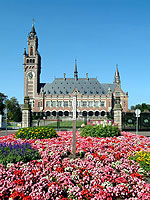
Speed skating is a very Dutch sport, because Dutch people have been doing it for more than 2000 years! It all started with the first people in the Netherlands. When it was winter, they wanted to catch fish on a lake. But how could they get to the middle of the lake? In the summer they had boats, but you can’t use boats if everything is frozen. So they started to walk on the ice, but that didn’t work (they fell down every time). So they putted a few bones of stags under their shoes and they tried to skate. That is how the people of Holland started skating! Now, people don’t skate anymore for fish, because we’ve got the supermarkets for that.
Every year, there are tournaments of speed skating, for men and women. Usually you skate on a circuit which is 400 meters long. It’s always going like this: 100 meter straight, 100 meter bend, 100 meter straight, 100 meter bend. After that you skated 1 lap (400m). There are different distances for men and women.
But not only the Netherlands take part in the championships. Also many other countries like Norway, Japan, China, Germany, France, Italy, the United States, Canada etc. Just watch TV and you will see it.
I have been doing it for 5 years now, and I like it very much. At school there’s also an ice-skating team, and I am in it. We’re skating games against other schools! A few weeks ago we had a regional tournament in Haarlem. We skated as fast as we could and my team (4 people) became second and now we are nominated for the Dutch Championship! There were also 4 other teams from my school which go to the DC!! We are we good in ice-skating, aren’t we?
Koen Kleiberg, T1A
Every year, there are tournaments of speed skating, for men and women. Usually you skate on a circuit which is 400 meters long. It’s always going like this: 100 meter straight, 100 meter bend, 100 meter straight, 100 meter bend. After that you skated 1 lap (400m). There are different distances for men and women.
But not only the Netherlands take part in the championships. Also many other countries like Norway, Japan, China, Germany, France, Italy, the United States, Canada etc. Just watch TV and you will see it.
I have been doing it for 5 years now, and I like it very much. At school there’s also an ice-skating team, and I am in it. We’re skating games against other schools! A few weeks ago we had a regional tournament in Haarlem. We skated as fast as we could and my team (4 people) became second and now we are nominated for the Dutch Championship! There were also 4 other teams from my school which go to the DC!! We are we good in ice-skating, aren’t we?
Koen Kleiberg, T1A








